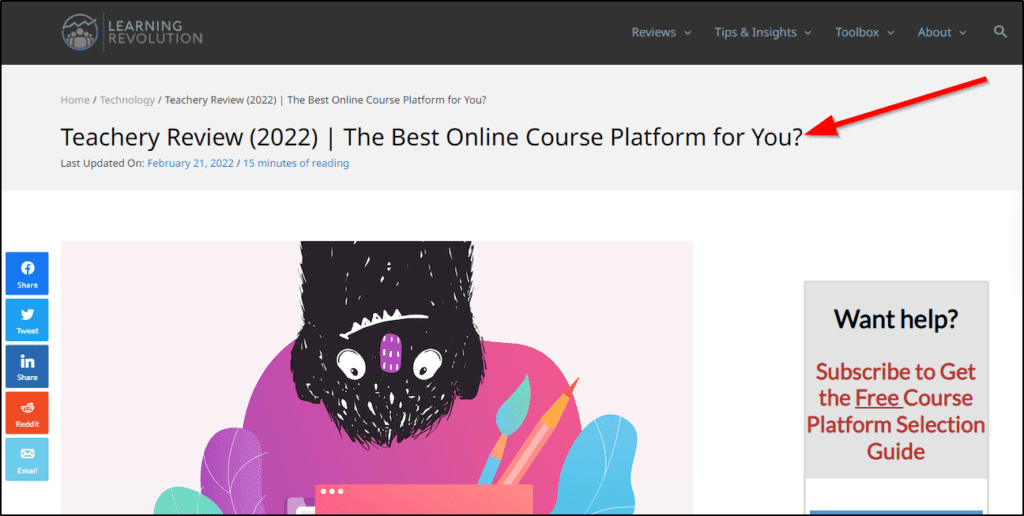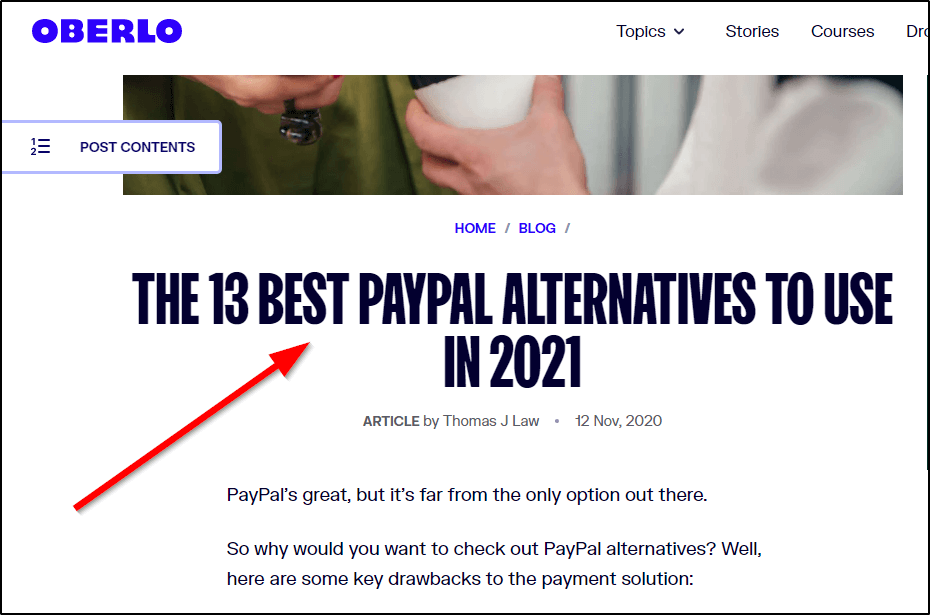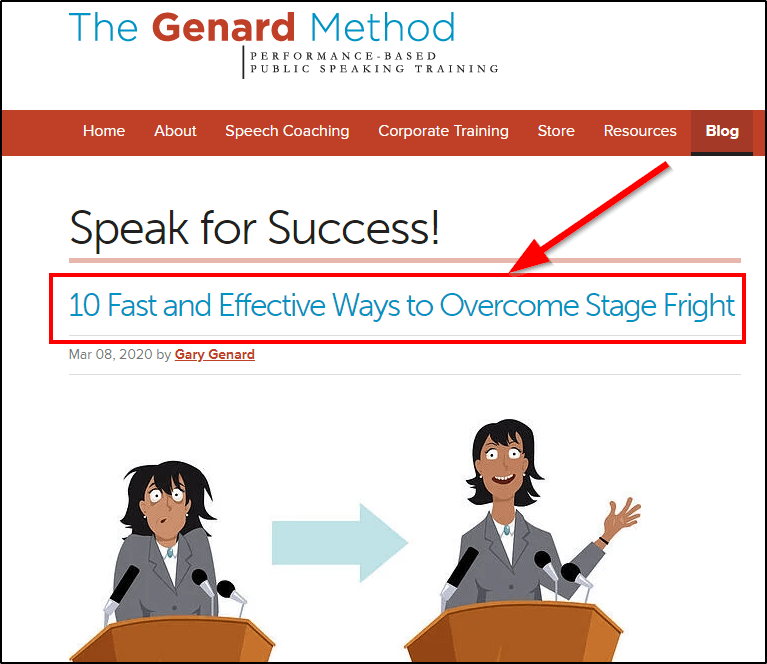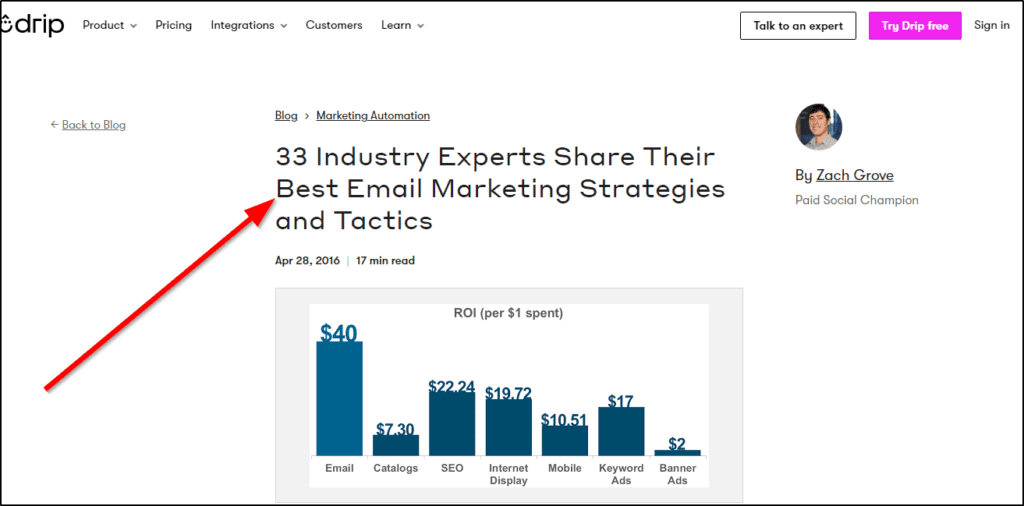
Everyone tells you that publishing high-quality blog posts is the best way to build your authority, drive SEO traffic, and attract leads for your online courses and other digital products.
I agree.
But here’s something most people don’t tell you.
Creating engaging, unique, and original content can be a daunting task and is among the most challenging parts of a marketer’s job. In a recent survey, 65% of respondents identified “finding interesting content ideas and creating engaging content” as their biggest content marketing challenges.
When I started blogging many years ago, I often struggled to come up with personal blog post ideas and fresh content for my business blog. Writer’s block is very real and it can make it feel impossible to keep coming up with new and relevant blogging ideas.
But don’t be afraid.
Because in this article, I’ll get your creative juices flowing with some of my favorite blog post ideas to help you stop staring at your screen and start writing. I share more than a dozen ways to generate great blog post ideas that your blog readers will love to read and share. Plus, I’ll share examples from other course creators successfully using blog content to drive their online course sales and blog traffic.
Sound good? Let’s dive in and explore some of the best blog post ideas to build traffic and engagement on your site, one post at a time, starting with your next blog post.
1. Talk About Your Audience’s Problems And Needs
Did you know that 68% of all online experiences start with a search engine query? Most of those queries are about people’s problems or needs. They’re looking for credible answers.
As an expert in your niche, you can use this as an opportunity to generate blog ideas that drive traffic to your site and establish your authority by creating content about your audience’s most frequent questions. The best blog posts ideas will align with clear answers to these common questions.
So list down their problems and needs, and address them one by one in detailed, high-quality, and actionable blog posts.
Here’s an excellent example.
Marc And Angel is one of the most popular sites in the self-improvement and relationship niche. This article perfectly aligns with the problems of its audience. It’s also consistent with their premium coaching program that helps people improve their mental health and relationships.
Here’s another brilliant example from Val Giesler’s blog.
Her audience consists of email marketers and copywriters, and she also runs a high-ticket coaching program for email copywriters.
The blog post in the screenshot above is about one of the most common problems of her audience and a perfect example of the kind of content that builds authority.
How do you find your audience’s questions?
Keyword research, review mining, analyzing forum discussions, etc., are excellent ways.
But let me share a quick and easy way.
To get more ideas for writing blog posts, search for your topic on Google and scroll down to the “People Also Ask” section on the results page.
For example, I found these questions when I searched for “email copywriting”.

These are the most frequently searched questions on this topic.
You can use each question to create a separate blog post topic, and it is guaranteed to generate traffic and interest – and this approach works whether you are trying to find lifestyle blog post ideas, business blog ideas, or anything else.
Use them as the starting point of your research to uncover dozens of other questions you can use to find timely blog post ideas.
2. Show Them Common Mistakes
Are you bored of writing about your audience’s problems and looking for something different? Show them the most common mistakes they should avoid.
You can use this angle in any niche because there’s always a right and wrong way to do things. Just as you want to avoid common blogging mistakes, people love experts who warn them of the pitfalls in advance so they don’t make the same mistakes.
Here’s an excellent example.
Mynda, the writer of this article, runs Excel and Powerpoint coaching groups and membership sites. So, this content angle is perfect for generating interest in her audience and building her authority.
Here’s another article that uses the same angle.
Many bloggers use this angle to generate blog post ideas and it’s pretty straightforward.
Just list down the biggest desires of your audience and identify the most common mistakes they should avoid while pursuing those dreams.
For example, finding high-paying clients is every freelancer’s dream.
Using this angle, you can create blog posts incorporating the following ideas:
- Mistakes to avoid when finding high-paying clients.
- Mistakes/reasons why you can’t find high-paying clients.
- Mistakes when negotiating freelance rates
- Mistakes in old pitching clients
3. Publish How-Tos and Tutorials
In-depth tutorials and how-to posts that teach readers how to perform a particular task or achieve a specific goal are excellent for building your authority and attracting traffic.
Using this angle, you can build up a variety of educational blog post ideas. Simply list all the core tasks or objectives your audience wants to achieve and then show them how to do it.
This super-detailed keyword research guide by Mangools is an excellent example of a high-quality blog post format for showcasing how-to content.
This how-to guide addresses each step of the keyword research process in detail, laying out everything the readers need to do to find profitable keywords.
Here’s another example of a well-written how-to article that shares the step-by-step details of creating a buyer persona.
Both these example articles are mammoth guides.
But you can apply the How-To angle to shorter articles as well. Instead of tackling a huge topic in an entire blog post, address smaller issues or break down bigger blog post topics into chunks to create more blog posts.
How-To posts are also ideal for adding Youtube videos. And remember, these don’t need to be fancy. Just record straight from your device and add them to your new or old blog posts to create engaging and fresh content.
4. Share The Best Tools And Products
Sharing the best products, tools, and software to achieve different goals is another proven angle that always works for generating blog post ideas.
Yes, these tend to be promotional blog post ideas, but your audience looks up to you as an expert to help them find the right products. You can make their life easier by publishing detailed product reviews that discuss the pros and cons of different products and help them decide if it’s worth buying.
Our Teachery review is a good example.

There are numerous software products in every niche which means you’ll never run out of content ideas using this angle.
However, it’s critical to remain unbiased in your reviews so that your readers get real value from your content and don’t lose trust in your advice.
Apart from dedicated product reviews, you can also publish lists of the best products for a specific goal.
Our list of the best online course platforms is an excellent example.

YYou can add more angles or qualifiers to develop new content marketing ideas for your product lists.
For example, this Hubspot post lists the best FREE email marketing tools.
Similarly, here’s an article specifically about startup project management tools.
Using other qualifiers such as “for beginners”, “free”, “for experts”, etc., you can expand your roundup blog post ideas to create multiple articles from just a single blog post idea.
5. Compare The Best Products
Product comparison is a similar content angle to the last one we discussed.
However, instead of giving readers a list of tools, you’ll take two or three tools and compare them feature by feature to help the readers find the most suitable option.
Comparisons are extremely popular in the software and SaaS niche, and almost every buyer searches for different comparisons before purchasing a product.
So, you can drive a ton of traffic to your site by ranking for a competitive comparison keyword.
This is why we regularly use this angle here on Learning Revolution.
This Podia vs. Teachable post is a perfect example.

Since you’re an expert selling online courses, people look towards you for product recommendations and helpful tips. Comparison posts are easily one of the easiest blog post ideas to come back to over and over again.
By objectively comparing different products, you can help your audience make the right choice, further strengthen your authority, and earn affiliate commissions as well.
6. Find Alternatives To Popular Products
Product alternative is another hugely popular content angle in the software niche.
Here’s how it works.
You pick a leading product from your own niche and write a post highlighting its equally valuable alternatives with your audience.
For example, if your audience frequently uses design tools like Canva, you can write a post listing its alternatives.
Similarly, if you create courses for freelancers or professionals who use PayPal for processing payments, an article about PayPal alternatives is perfect for your audience.
Finding alternatives to a popular product is pretty simple.
You can find dozens of products for every niche on sites like Capterra and G2. Just make sure that the products you shortlist in all the posts offer similar features and cost roughly the same amount of money.
7. Share Success Stories
If you’re an experienced online course seller, you’ll probably have many successful students who’ve excelled in their lives because of your courses.
Have you highlighted their success stories in your content?
If not, it’s a great way to engage your audience, strengthen your authority, drive traffic, and generate more leads for your courses and other offerings.
Why? Because success stories are among the most effective forms of social proof. They give your audience a behind-the-scenes look at how your course positively impacted somebody else’s personal life. This sneak peek will motivate your audience to take action and persuade unsure prospects to buy your courses.
For example, John McIntyre, a hugely successful email copywriter who sells multiple online courses, regularly features stories from his successful students.
Here’s another example from Starter Story, a community of successful entrepreneurs.
The great thing about this content angle is that you’ll never run out of great blog post ideas if you regularly train students in your courses.
So, you can easily create these blog posts every month or quarter or when getting close to your course launch. You can also reach out to see if any students may be interested in guest posting on your site regularly on a particular blog topic.
The key to a compelling success story is to highlight the challenges a person faced before taking your course, how your course helped them, how they implemented it, and the results they achieved with it. Showcasing real-life events with personal and meaningful conversation around the impact of your course can be very powerful.
Clearly lay out these steps in your blog post to address your audience’s objections and convince them to buy from you.
8. Interview Experts And Successful People
Let’s say you don’t have any success stories yet. Or even if you have some, you want to try other content angles.
No problem.
Another source of blog post ideas is to interview subject matter experts and successful entrepreneurs from your industry who have achieved things your audience wants to accomplish. Not only will this create meaningful blog content but it will draw in website visitors who you might not have otherwise attracted.
Here’s an excellent example from Wordable’s blog.
Here’s another example from Kajabi’s blog.
They interviewed Amy Porterfield, a well-known consultant, and turned it into a video blog post.
People love interviews because of the value they’re packed with value and expert insights. However, landing interviews with influencers and well-known experts in your industry isn’t easy because they’re busy people.
So, if you’re not an established course creator with a large audience, your best chance is to target second-tier influencers who’re still actively interacting with their audience.
Keep an eye on the active users in relevant Twitter threads and discussions in your niche. You can find micro-influencers and lesser-known experts there.
9. Share Tips To Help Them Improve
The success of a content strategy largely depends on the quality of its informational content.
Why? Because informational content is based on mid to high-volume search queries and addresses topics that people frequently search for.
These articles share practical tips and actionable steps to help your audience improve in different ways. They not only drive traffic to your site but also help you strengthen your brand image by sharing unique and helpful advice.
Here’s an excellent example of this content angle.
Notice how the article’s topic closely aligns with the premium course offered on this website. This kind of content builds authority and generates leads for your courses.
Here’s another example, this time from Backlinko.
This article is about SEO tips, and it perfectly aligns with Backlinko’s premium SEO course that dives much deeper into these tips.
So, how do you find blog post ideas using this angle?
Think of the different goals your audience wants to achieve.
For example, if you sell online courses about graphic design, here are some topics you can address using the “tips” angle:
- Graphic design tips
- Logo design tips
- Website design tips
- Email design tips
- Sales page design tips
- Landing page design tips
- Social media design tips
Now, start adding qualifiers to each idea to find more unique angles.
- Graphic design tips for beginners
- Graphic design tips for startups owners
- Visual design tips for busy entrepreneurs
- Logo design tips for a tight budget
- Website design tips for SaaS
Want more blog post ideas? Add the current year at the end of your titles.
- Best graphic design tips for 2022
- Website design tips for startups in 2022
- Logo design tips for 2022
As you can see, you can find numerous content ideas and angles by simply sharing tips around the topics your audience cares about.
10. Cover The Fundamentals Of Your Niche
One of the best ways to establish your authority and attract thousands of visitors to your site is by publishing content about the fundamentals of your niche.
Why? Because most internet users who search for different topics are beginners looking to understand the basics of a topic.
So, instead of jumping right into the advanced topics of your niche, make sure you cover the fundamentals first.
Here’s an excellent example.
SendInBlue is an email marketing tool, so this article aligns perfectly with its audience’s interests.
Ahrefs, the world’s leading SEO tool, has also ensured that its blog covers all the fundamental topics of its niche.
Since you’re an expert in your field, writing such articles should be a problem.
For example, if you sell courses about mental health, here are a few content ideas you can use.
- What is mental health?
- What are common mental health problems?
- Misconceptions about mental health.
- What are the symptoms of mental illness?
- What are the causes of mental illness?
For an expert, these aren’t advanced topics that require a lot of time or research to write. But they’re in high demand.
Another significant advantage of this content angle is that it allows your site to rank for Google’s featured snippets, the answer Google shows at the top of the search results.

Ranking for featured snippets has almost the same effect as ranking on the number spot in search results.
But here’s the best part.
You don’t need to rank on top to make it to the featured snippet.
Instead, Google will rank any page from the first page in the featured snippet if it adequately answers the searcher’s question.
In short, publishing articles on the fundamentals of your niche can help you drive tons of traffic to your site. So, whenever you are struggling for great blog post ideas, be sure to review the fundamentals.
11. Publish Expert Roundups
Remember the expert interview content angle? If that’s too hard to pull off, try publishing expert round-ups.
What is an expert round-up? These articles feature the answers of multiple experts to a particular question.
For example, this article asked 20+ Facebook ads experts to share their favorite advertising strategies.
Similarly, this article on Drip’s blog shares the best email marketing tips by 30+ industry experts.
This content angle has numerous benefits as a way to come up with blog post ideas.
First, it’s not as hard to pull off as an interview.
Why? Because interviews are time-consuming. On the other hand, a round-up asks a very specific question and requires a brief answer.
This makes it more convenient for the experts.
Secondly, roundups can drive a lot of traffic to your site.
How? When you publish a roundup of 20 or 30 experts, most of them share your article with their followers. Some even link back to it in their content.
This directly boosts your site’s exposure and traffic.
12. Recommend The Best Resources
We’ve already discussed how people want you to recommend the best tools for their business since you’re an expert.
But here’s another similar angle you can try.
This time, create posts where you recommend helpful resources like books, events, blogs, podcasts, or even courses for different objectives.
For example, this article shares the best books for SEO professionals.
Here’s another article that lists the best self-help podcasts.
The great thing about this content angle is that it can be used in any niche because you can find events, books, podcasts, etc., on all sorts of topics.
13. Make A Prediction
Everyone wants to know the future to prepare better.
Since you’re an expert, you’re qualified to predict your industry’s future direction and trends.
This is an excellent content angle for a few posts at the end of the year.
Here’s an example from a CMI blog post.
Here’s another article that makes predictions about the future trends of the email marketing industry.
As your predictions come true, you can refer back to them in your content showing your audience that you’re the real deal. Keep in mind, too, that this may be a good area for controversial blog post ideas – don’t just say what everyone else is saying.
14. Publish Survey Results
Do you have a large email list or a substantial social media following? If yes, consider running different surveys on your audience from time to time and publishing the results in your blog posts.
This approach is excellent for building backlinks to your website since most websites and content creators love to link back to original research and data sources.
You can run surveys using social media features such as Twitter or Facebook polls. Or you could use a survey tool to create a questionnaire and share it with your audience via email.
Here’s an excellent example of this content angle from Kyle Byer’s blog.
Kyle conducted this survey on his audience and organized the results in this blog post. It became a huge success and increased the traffic to Kyle’s site by almost 900%. Plus, it attracted hundreds of backlinks, increasing the overall website authority substantially.
Are You Ready To Find New Content Ideas For Your Blog?
As I said at the start, finding content ideas can be hard. But the blogging tips, techniques, and content angles I’ve shared will make your job significantly easier. Think of them as templates to find new blog post ideas. Heck, you can even ask your audience directly if they have any fun blog post ideas for you. The point is, if you truly understand your audience’s needs, you can use these angles to find new ideas and write blog posts that build your brand authority, drive traffic, and generate leads for your online course.
Hopefully, this gave you some great ideas to write your next epic post. But don’t stop here. Make it part of your morning routine to take time to brainstorm new ideas and future blog post ideas. Stay on top of what other bloggers in your market are writing about and continue to perfect your writing style and grow your blog post ideas one day at a time.
Feel free to share some of your creative blog post ideas in the comments!
Table of Contents

























Related Posts
Podia Blogging: Manage Your Blog and Other Digital Products in One Place
15+ Essential Email Sequences For Online Course Creators (2023)
How to Make Money Blogging